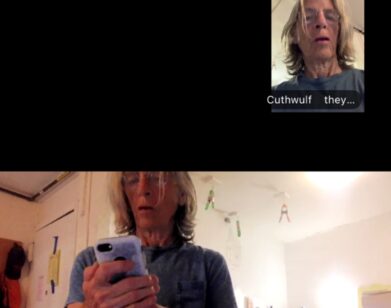Menswear Monday: Jeremy Laing
The invitation to Jeremy Laing’s Spring 2014 show earlier this month announced that the designer had a surprise in store this season: menswear. In between the run of women’s looks on his Pier 59 runway (which he’s been showing since 2005), Laing sent out a complementary set of men’s looks finished in pinstripes, particolored prints, and neoprene. The scene was an early-’90s, “Malibu sunset beach rave,” he said. In simpler terms, that translated to something fun.
This wasn’t Laing’s first time doing menswear. He got started in fashion designing his own clothes in high school. “I just wanted to make something for myself again,” he admitted. “It’s kind of selfish, ultimately.” Laing’s signature women’s collection has always been fairly androgynous, so the men’s addition to his line was no stretch. Several of the pieces on his spring runway showed up twice: once on each gender, resized for different frames and done in different colors. They had all the hallmarks of the Laing brand: boxy cuts, high-tech textiles, and painterly patterns (this season, courtesy of New York artist Julia Dault), and they looked just as good on men as they long have on Laing’s women.
We connected with the designer to hear more about his new men’s project while he was on the train between Paris and London getting ready to push his latest venture at slew of sales meetings.
NAME: Jeremy Laing
BASED IN: Toronto, Canada
SHOWING IN: New York
ORIGIN STORY: I went to an integrated arts high school, so it was a very creatively exploratory time. [laughs] I did a lot of things—painting and art—and I took fashion classes and sewed things. I had all of these creative outlets, and ultimately through college, in terms of focusing on just one thing, it became the path that it became. I did an internship with McQueen along the way that was really formative, and I did some art projects here and there as other things to keep me creatively engaged. Starting my own line was a bit of a whim. I had a friend who had a gallery space that was available, so I just decided to come down from Toronto and put on a little show. And it just kept going.
TRADEMARKS: I do most of my own patternmaking. I have a really hands-on approach there. A lot of it tends to be working on the process and elaborating on a certain technique and seeing where that leads—it’s not very blueprinted. It leads to a very shape-based construction, focusing more on that than surface embellishment. My textiles are pretty signature; we do a lot of developmens in terms of prints and treatment. And we did a lot of bonding this season. We like being able to develop along those lines, especially as a small company. Those are definitely a couple things.
OH, CANADA: I have an amazing studio in Toronto. [laughs] I just love the price that I got on a really huge, amazing studio. It’s a really livable city. I kind of came into my own as an adult there—I went to college there, I found my roots there, my element. It has a really thriving arts scene and a really strong music scene. It’s a place where it’s really easy to create because there are fewer barriers to entry, so to speak. People just do things for the sake of doing things still, which is nice.
FASHION MODELS: In terms of my staying in Toronto and showing in New York, I was definitely inspired to work that way by the history of the Antwerp Six. You know, tending your rose garden and then taking your clothes where people will see them. Certainly in terms of business strategy, the same company mentality that they started with, too. I can really appreciate the designer-owner model—that’s sort of on the business side, I guess. On the style side of things, everyone loves Bianca Jagger in a pantsuit. And everyone loves Tilda Swinton. So that’s sort of where I’m coming from.
NEXT BIG THING: We’ve been working a lot with bonded materials that we garment-dyed, so doing a lot of sewing the garment and then dying it in a wash afterwards, and playing with the composition of fibers so that there’s a kind of spontaneity in the end result that you’re actually planning for. If you mix a nylon with a cotton and dye it together, it’ll come out slightly differently. One will shrink differently, and so on. We’ve gotten into some fabrics that separate into two layers when they get washed—when we dye it and wash it, it un-aligns, sort of as a byproduct, and you get these different layers to it. We’re working a lot with responsive textiles and playing with and manipulating the responses that we’re expecting.
BOYS VS. GIRLS: My approach even for womenswear can be a little menswear-ish—some of those androgynous shapes like a big trench coat or men’s tailoring. But I think that men’s has a few things that women’s doesn’t: the history of tailoring around it and the way men’s clothes have been constructed. Women’s tailoring has come so far that maybe that’s evened out, but menswear seems to be more solution-oriented, typically. It’s slower-moving, so perhaps it follows a slower-changing logic that leads to it being more solution-based. In terms of the fashion cycle, it’s changing just as quickly and it’s just as rapid and carnivorous. It’s still all very archetypal, maybe there are just more archetypes to embody nowadays.
Menswear Monday runs every other Monday. For more, click here.







